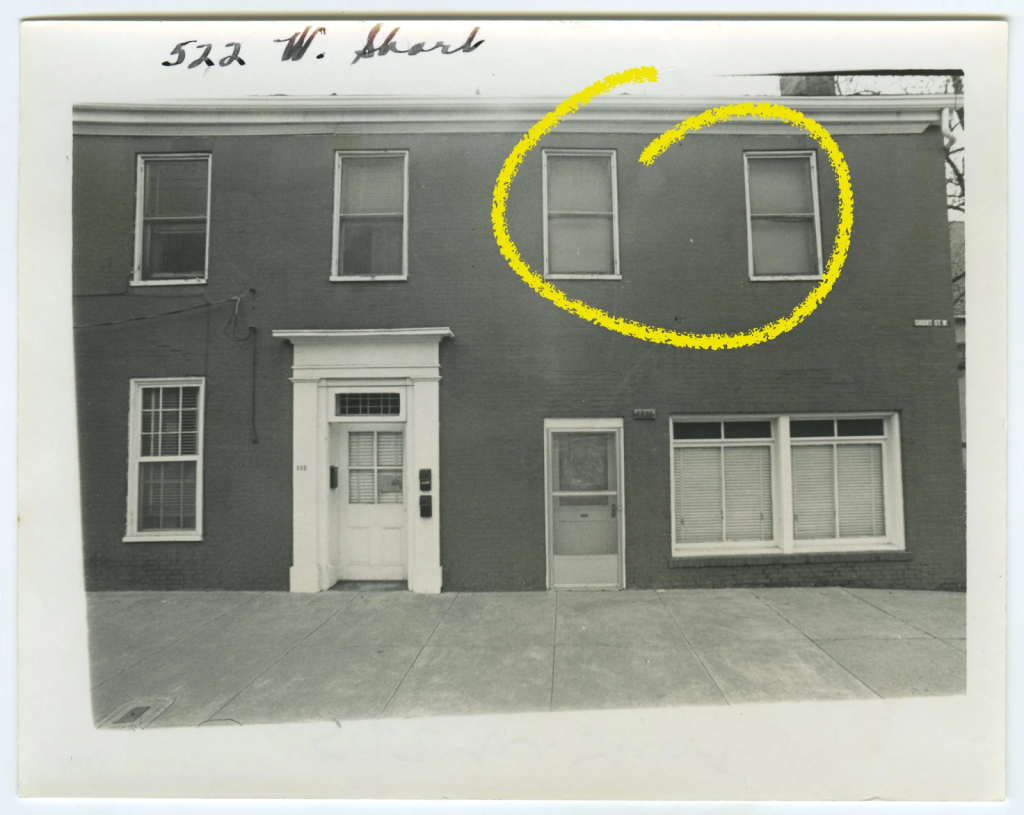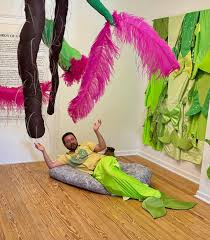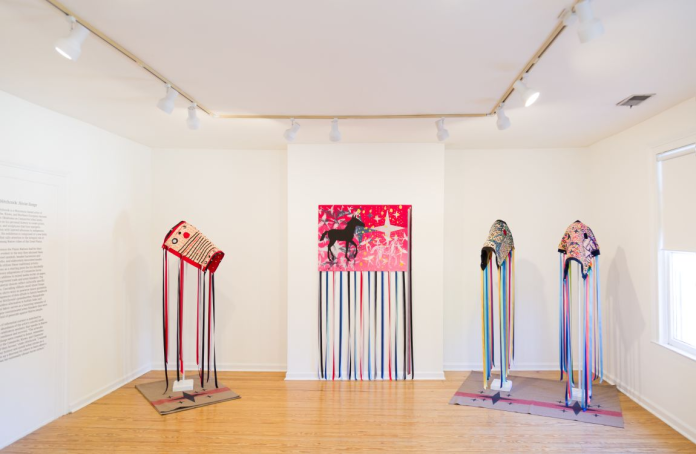
2nd Story (seen above) is a nonprofit arts organization that specifically focuses on supporting artists who take risks with their work. Not only does 2nd Story look for the element of risk, but it also aims to support work that brings up topics integral to our social and political climate. This mission brings people together in a common third space, and it sparks a conversation that may have never happened without the aspect of art. Through this, I have identified the aspects of community and binding people together, which are also highlighted through Brian Eno’s book, What Art Does. Eno is a producer, musician, and composer who produced legendary albums for David Bowie, U2, and the Talking Heads. He is also an author who has explored the theories of art within society. Eno talks about how art brings a community together and shows how this way of exploring political issues is the safest route to challenge our ideas. In this space of welcoming community, we can begin to open our minds to understand the perspectives of others. Through viewing art, we can begin to have difficult conversations. Eno highlights this aspect of art as a trigger to seeing the world, but in an escapable format that makes us feel safe. These difficult conversations about social and political issues can be seen as an act of resistance.
Art is one way to bring out what needs to be talked about more in our society. It highlights the things we forget about and the issues we often don’t encounter. Eno puts it as taking in things from other worlds. From this, it can be said that art is a way of achieving a better society and civic health in a community. Eno brings up many aspects of what art does. Many of these features connect with what 2nd Story is achieving as a successful arts organization. 2nd Story reflects a multitude of Eno’s ideas by fostering a sense of community and curating safe risk-taking to encourage the growth of Lexington’s civic health. Eno highlights how art impacts the way we see the world. The concepts of world-seeing and 2nd Story’s mission for taking risks create an excellent space for new ideas. Eno brings up how humans typically need just a small push to realize big things: “We need only very little information and in the right context we can make huge leaps of the imagination, extrapolating that information to an entire world” (Eno, pg 42). 2nd Story facilitates this push for many individuals who walk into the exhibition space.

While I was interviewing Leah Kolb, director and curator of 2nd Story (seen on the left), she described how each exhibit sparked some type of conversation by saying, “Even if people don’t like the work that’s on view, like thirty mermaid tails, at least it can be a prompt to think about things.” Eno further emphasizes this idea of art as an escapable reality in which we can learn more about ourselves and other individuals: “When you are looking at art, you are looking at differences” (pg 48). By stepping into 2nd Story, one can learn all about queer theory, Native American heritage, or the importance of parks. The amazing aspect of 2nd Story that Eno highlights is that it is purely escapable. Just as you have the power to step in, you have the power to step out. There is something very special about this modality of learning. Although 2nd Story promotes artist risk-taking, the consumers of the art do not have to risk anything at all. Eno supports, “Art is effective because it is safe… you can go away and you can get back to your life” (pg 35). Eno and 2nd Story deeply connect in this aspect. Art is about learning, and 2nd Story uplifts diverse voices for us to learn about hard topics and important perspectives in a safe way. Both Eno and Leah discuss how art and art spaces bring people together.
2nd Story is relatively new to the Lexington art community, and Leah described how getting their name out there felt like “a slow burn.” Leah talked about how the location of 2nd Story did not make it easy for individuals to simply stumble into the gallery (location in building seen on right). However, she views this as a positive: “You have to come here with some sense of intention.” While Leah flipped this negative attribute to something positive, she noted that they faced a lot of hardships while trying to get 2nd Story’s name out there.
2nd Story also supports academics by hosting informational talks along with exhibitions. For example, a Professor of Geography came to talk about Lexington’s parks alongside an exhibit full of national park images. This brings in more spectators to 2nd Story. Leah noted that by bringing in these educators, they “brought their people with them” and increased 2nd Story’s audience.
2nd Story also works with LexArts to participate in the Art Hop and add their events to the community calendar. Through all these communicative initiatives, 2nd Story is building their audience and adding to the Lexington community. There are not a lot of places in our world where humans can just exist with each other. Art spaces create this community where we can not only exist together, but also begin to understand our feelings. Eno brings up how art helps us process our emotions and feelings. This experience of processing life together builds community. Life can be scary, and we often struggle to see things clearly without the impact of art or other people. Eno emphasizes, “we only have one life, and one chance to see what works and what doesn’t” (pg 27). We need community art spaces to make sense of the world. While 2nd Story is still working on their outreach, they have created a space that fosters community with thought-provoking exhibitions and events.

While Leah talked about the amazing things 2nd Story does, she also mentioned what it is like being a nonprofit arts organization during this time of political crisis. She discussed how she feels 2nd Story’s purpose is more important than ever in times like today. She described 2nd Story being in a “lucky position” due to the fact that they do not have to operate under a larger organization telling them what they can and cannot do. However, for Leah, owning a nonprofit means that a lot of it is funded by herself. She has such a strong motivation to continue 2nd Story’s work that she works a second job to keep things afloat. While 2nd Story needs stakeholders and supporters to keep it going, it has to start by giving back to the community. This can be seen through 2nd Story’s Bridgework program, which supports emerging artists. As becoming an artist in today’s society grows increasingly more difficult, programs like Bridgework are what we need to support young artists. I believe that through this pathway for emerging artists, 2nd Story is ensuring we will continue to be an artful society.
Bridgework acts to give back to the community and to improve Lexington’s civic health by uplifting artists with important stories to tell. Eno emphasizes this need for art and civic engagement in his book. He states, “What an artist chooses to write or make drawings or songs about, can draw our attention to certain worlds. It tells us that somebody takes something seriously, perhaps finds it beautiful or threatening, and invites us to rethink how we feel about it” (Eno pg 82). By creating this mentoring program for more artists to show various worlds, 2nd Story is keeping art alive. Eno believes that it is art that keeps a community thriving and successful. Through the impact of Bridgework, Lexington’s civic health will improve. Eno supports this by saying, “Art is that cloud; a reservoir of shared experiences that gives us ways of sharing complex feelings and ideas with each other. It’s the lifeblood, the lubricant, the circulatory system of community, the maintenance of community” (pg 96). Leah further described the Bridgework programs as an ecosystem of artists that allows them to make connections with mentees from other programs in Madison and Milwaukee. Sadly, the majority of Bridgework organizations are collapsing due to funding and administrative issues. Now, more than ever, 2nd Story’s team is having to brainstorm communicative strategies to keep their organization alive.

There is something really special about a local organization that uplifts artists who make things simply for the sake of doing so. 2nd Story’s mission statement and initiative as an organization connected heavily with the major themes of What Art Does. 2nd Story is one of many organizations in Lexington that foster this community of thinkers, idea challengers, and information yearners. They take the world we live in and truly make something of it. Whether it is interactive and playful art like wearable mermaid tails (seen on the right), or photography highlighting our national parks, every exhibit gives us something to talk about and a new perspective on how we see the world. This is exactly what Eno does throughout his book. Eno and 2nd Story both provide this guideline of surviving and show that we don’t have to get through life alone. We always have art and the people it brings together.



